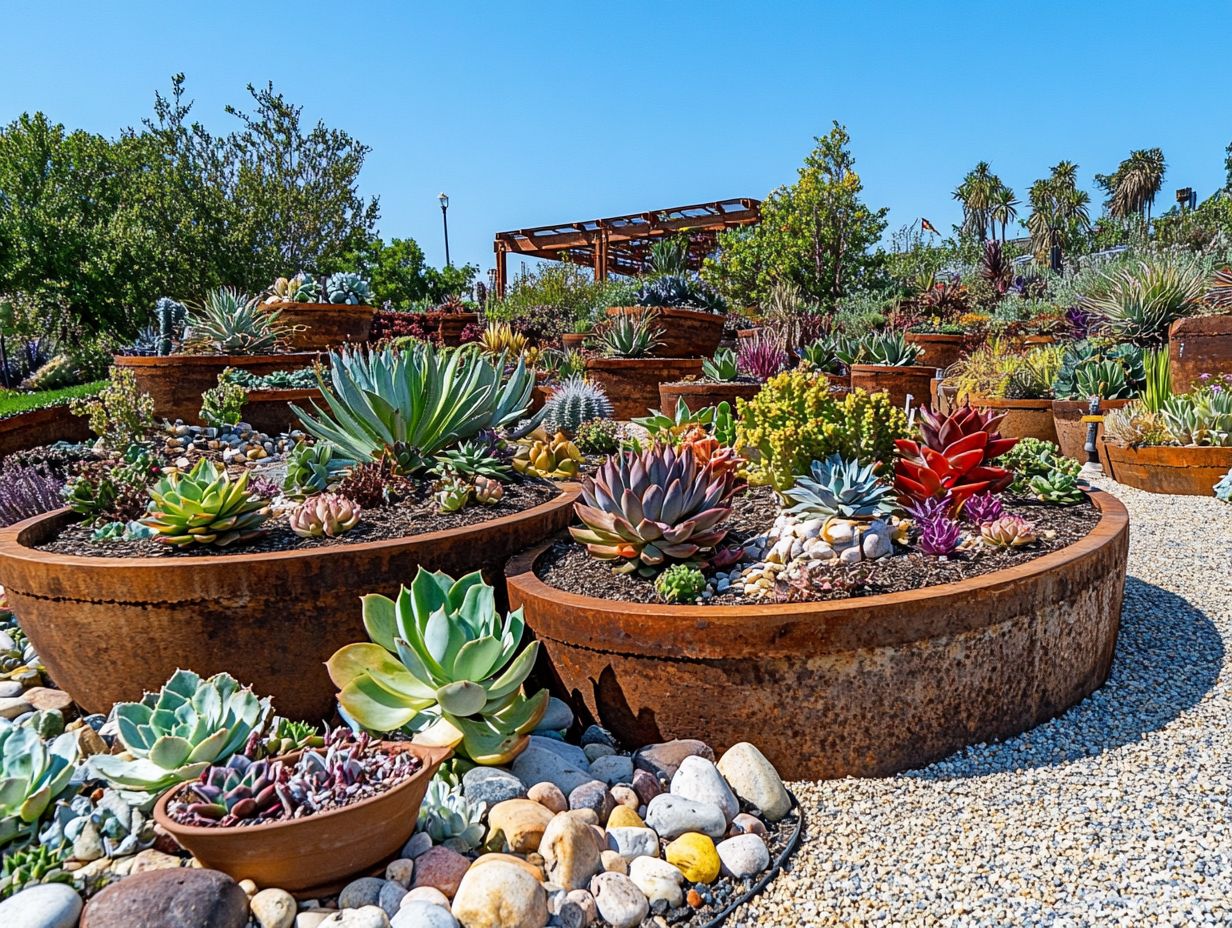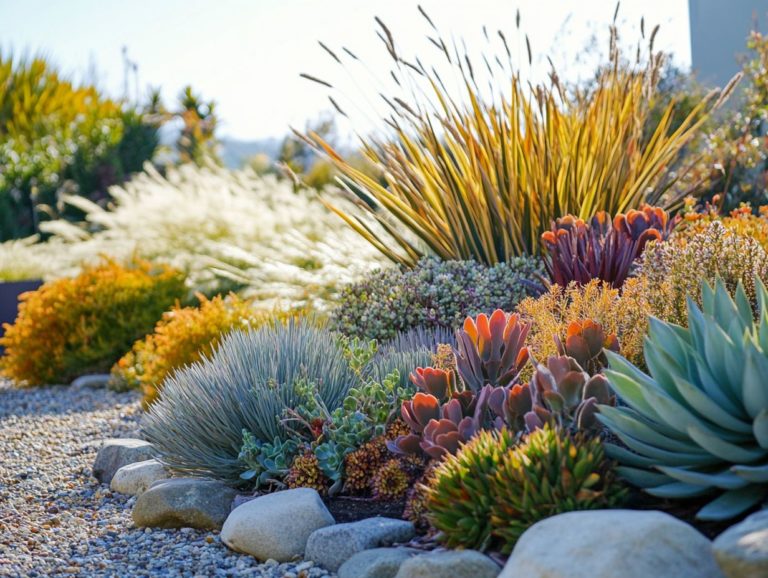Creative Ways to Utilize Drought-Resistant Plants
Drought-resistant plants offer more than just a smart solution for water conservation; they serve as a vibrant enhancement to any garden or home.
In this article, you ll explore what these resilient plants are and uncover their numerous benefits. From designing breathtaking drought-resistant gardens to seamlessly incorporating them into your indoor spaces, get ready to fully embrace these hardy beauties.
You will discover inventive DIY projects and culinary uses that enhance your surroundings and lifestyle. Prepare to transform your gardening approach into something truly remarkable!
Contents
- Key Takeaways:
- Understanding Drought-Resistant Plants
- Landscaping with Drought-Resistant Plants
- Indoor Uses for Drought-Resistant Plants
- Creative Ways to Incorporate Drought-Resistant Plants
- Frequently Asked Questions
- What are drought-resistant plants?
- What are some creative ways to use drought-resistant plants in my garden?
- Can I use drought-resistant plants in my indoor spaces?
- How can I incorporate drought-resistant plants into my cooking?
- What are some benefits of using drought-resistant plants in my garden?
- Are there any specific care instructions for drought-resistant plants?
Key Takeaways:

- Incorporate drought-resistant plants in your landscape design to save water and create a beautiful, low-maintenance garden.
- Indoor uses for drought-resistant plants include decorating with succulents and creating a low-maintenance indoor garden.
- Get creative with drought-resistant plants by using them in DIY projects, decor, cooking, and crafts.
Understanding Drought-Resistant Plants
Understanding drought-resistant plants is essential in today’s climate, where water scarcity and dry conditions pose significant challenges to your gardens and landscapes. As climate change continues to influence global weather patterns, choosing the right drought-resistant plants can pave the way for sustainable gardening practices.
These remarkable plants are specifically adapted to thrive in arid environments, requiring less water while still offering visual appeal. By embracing eco-friendly landscaping techniques like xeriscaping (designing landscapes to reduce the need for irrigation), you can cultivate stunning landscapes that conserve water and enhance soil health, ensuring that your gardens flourish even in the toughest conditions.
What are Drought-Resistant Plants?
Drought-resistant plants are your allies in the quest for a thriving garden under dry conditions. These specially adapted species minimize your reliance on additional water sources. Consider exploring unique drought-resistant plants for your home, such as succulents, cacti, and ornamental grasses; they are experts at storing moisture, making them perfect for low-water landscapes.
These extraordinary plants have evolved a range of adaptations that enhance water retention, such as thickened leaves and reduced leaf surfaces. For example, succulents feature fleshy leaves that hold moisture, while native plants boast deep root systems that tap into water stored far below the surface.
By integrating these resilient varieties into your garden, you can cultivate sustainable environments that not only require less maintenance but also foster biodiversity. Strategically using drought-resistant flora can help you combat the impacts of climate change and water scarcity, leading to more resilient and eco-friendly gardening practices.
Benefits of Using Drought-Resistant Plants
Using drought-resistant plants in your landscaping not only elevates the aesthetic appeal of your garden but also brings a host of practical benefits, such as water conservation and improved soil health. These tough plants need very little water, making your gardening efforts much easier!
By opting for these hardy plants, you conserve precious water resources while enjoying a vibrant landscape that actively contributes to environmental sustainability. The reduced need for frequent watering translates to lower maintenance costs and less time spent on upkeep, allowing you to relish more moments of leisure in your outdoor sanctuary.
Another significant advantage is their ability to prevent soil erosion. These robust plants establish deep roots that anchor the soil in place, preserving its integrity. The diverse range of drought-resistant plants also enhances biodiversity, providing habitats for beneficial insects and wildlife, which promotes a healthier ecosystem overall.
Incorporating these plants into your landscaping not only creates a visually stunning garden but also fosters long-term soil health and contributes to environmental well-being.
Start your gardening adventure with drought-resistant plants today and watch your garden thrive with minimal effort!
Landscaping with Drought-Resistant Plants
Landscaping with drought-resistant plants lets you create beautiful outdoor spaces that are both attractive and sustainable. To enhance your efforts, consider how to create a drought-resistant garden by incorporating a diverse selection of low-water plants into your garden for a thriving environment in arid conditions.
Implement efficient watering systems to save water and enhance the beauty of your landscape.
Designing a Drought-Resistant Garden

Creating a drought-resistant garden requires careful planning and choosing plants that thrive in dry conditions. Consider the role of drought-resistant plants in landscaping, using native plants, applying mulch for moisture retention, and grouping plants with similar watering needs.
By focusing on drought-resistant plants for a colorful garden, you’ll cultivate vibrant landscapes with less maintenance and irrigation. For instance, opt for succulents like agave or sedum to boost your garden’s appeal while conserving water.
A generous layer of organic mulch, such as wood chips or straw, helps suppress weeds and retain moisture. Group plants by their watering needs to create an efficient irrigation system.
Look to successful examples like the Xeriscape gardens in California and Arizona. These gardens showcase how techniques can transform dry landscapes into lush retreats.
Choosing the Right Plants for Your Landscape
Selecting the right plants is crucial for creating a vibrant, drought-resistant haven. Focus on integrating drought plants into landscapes that match your garden’s style.
Evaluate the water needs of each plant to ensure they fit harmoniously with your landscape. For example, vibrant flowering plants like lavender and salvia thrive in dry conditions while adding stunning visual appeal.
Incorporating groundcovers like creeping thyme or sedum minimizes soil erosion and reduces weed growth. Combining beauty and practicality creates a harmonious space that thrives in challenging conditions.
Indoor Uses for Drought-Resistant Plants
Indoor gardening is on the rise. By incorporating drought-resistant plants like succulents and cacti, you can create a stunning, low-maintenance indoor garden.
These plants enhance your interior design and require minimal care, making them perfect for busy lifestyles.
Decorating with Succulents and Cacti
Using succulents and cacti provides a unique chance to bring nature indoors. These drought-resistant plants can be arranged in various containers, turning them into captivating art pieces.
Adding these resilient plants creates a serene atmosphere in your home. Imagine eye-catching arrangements in terrariums or rustic wooden boxes that complement your decor style.
Selecting ceramic pots with unique designs allows these plants to become focal points, seamlessly blending indoor gardening with your design vision. With thoughtful placement, succulents and cacti can transform any corner into a refreshing green sanctuary.
Creating a Low-Maintenance Indoor Garden
Creating a low-maintenance indoor garden is not just easy; it’s fun and rewarding! Choose drought-resistant plants that need minimal care and attention to their watering needs.
By selecting the right additives for soil and understanding each plant’s requirements, you can cultivate a thriving indoor space without overwhelming yourself.
Start by selecting resilient options like succulents, snake plants, or pothos. These beauties flourish in a variety of conditions and need watering only occasionally. To elevate your soil game, consider adding perlite or coconut coir, which enhance drainage and aeration, ultimately nurturing healthy root growth.
Establish a simple care routine, perhaps opting for bi-weekly watering or utilizing self-watering pots, which automatically adjust moisture levels according to each plant’s specific needs. Choose decorative planters to maintain aesthetic appeal, and group plants with similar hydration requirements to streamline your care efforts.
By adopting this thoughtful approach, you ll create an inviting indoor garden that showcases vibrant greenery while keeping maintenance to a minimum.
Creative Ways to Incorporate Drought-Resistant Plants

Incorporating drought-resistant plants into your creative projects can unlock your creativity in numerous ways, ranging from culinary applications to innovative DIY crafts.
These plants can be seamlessly woven into functional garden elements and one-of-a-kind creations.
DIY Projects and Decor Ideas
Engaging in DIY projects with drought-resistant plants offers you the opportunity to create unique garden features that reflect your personal style while promoting innovative techniques for drought landscaping.
From custom planters to vertical gardens, these projects can transform both your outdoor and indoor spaces into creative showcases. By selecting plants that require minimal water, you reduce your environmental footprint and contribute to resilient ecosystems.
Simple projects, like crafting a stone succulent garden or installing a rain barrel, can be incredibly gratifying.
To build a stone garden, gather materials such as pebbles, sand, and a selection of drought-resistant succulents. Start by laying out your design while ensuring proper drainage. Then, fill the area with pebbles and sand, placing your plants strategically for optimal sunlight exposure.
Through these engaging activities, you ll find immense satisfaction in nurturing a sustainable garden while reveling in the beauty of a thriving space.
Using Drought-Resistant Plants in Cooking and Crafts
Drought-resistant plants offer a delightful opportunity to elevate both your cooking and your crafts. Many low-maintenance, drought-tolerant plants, particularly herbs, can infuse your dishes with flavor while simplifying your gardening efforts.
Incorporating these plants into your meals not only enhances the taste but also champions sustainability in your cooking practices. For example, succulents like jade or specific varieties of lavender can add a stunning garnish to your plates or be infused into oils and teas, providing a distinctive twist to your traditional recipes.
Engaging in creative crafts with these plants, like terrariums or potpourri, showcases their aesthetic charm while serving practical purposes. By merging culinary creativity with craft projects, you can truly appreciate the versatility of drought-resistant plants for small spaces, transforming them into invaluable assets in your home.
Frequently Asked Questions
What are drought-resistant plants?
Drought-resistant plants are those that can survive with little water. They have special features like deep roots or thick leaves that help them keep moisture.
What are some creative ways to use drought-resistant plants in my garden?

One way to use drought-resistant plants is to create a rock garden. This type of garden combines rocks, gravel, and innovative ideas for drought gardening for a low-maintenance and water-efficient landscape.
You can also use these plants in containers, hanging baskets, or as ground cover.
Can I use drought-resistant plants in my indoor spaces?
Yes, many drought-resistant plants can thrive indoors. Succulents, cacti, and some palms need minimal watering and can add a lively touch to your home or office.
How can I incorporate drought-resistant plants into my cooking?
Plants like rosemary, lavender, and thyme not only beautify your garden but also enhance your meals. Use them in marinades, rubs, or as garnishes to add a unique and delicious touch.
What are some benefits of using drought-resistant plants in my garden?
Drought-resistant plants require less water and maintenance, making them a smart choice for your garden. They help conserve water and reduce the need for harmful pesticides and fertilizers.
Are there any specific care instructions for drought-resistant plants?
Drought-resistant plants are hardy, but they still need proper care. Plant them in well-draining soil, ensure they get enough sunlight, and water them deeply but infrequently to support deep root growth.
Regular pruning and removing dead or damaged parts are also important for their health.






